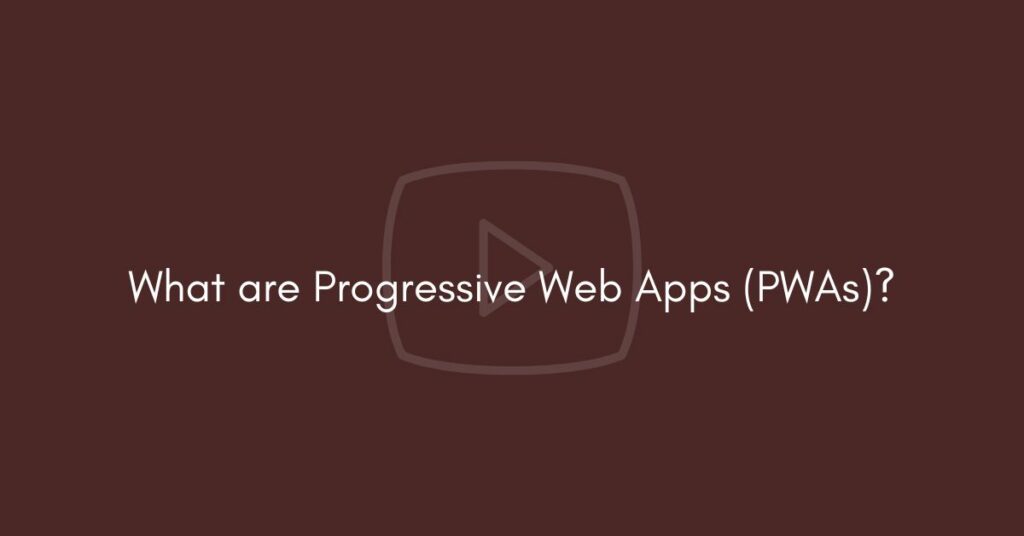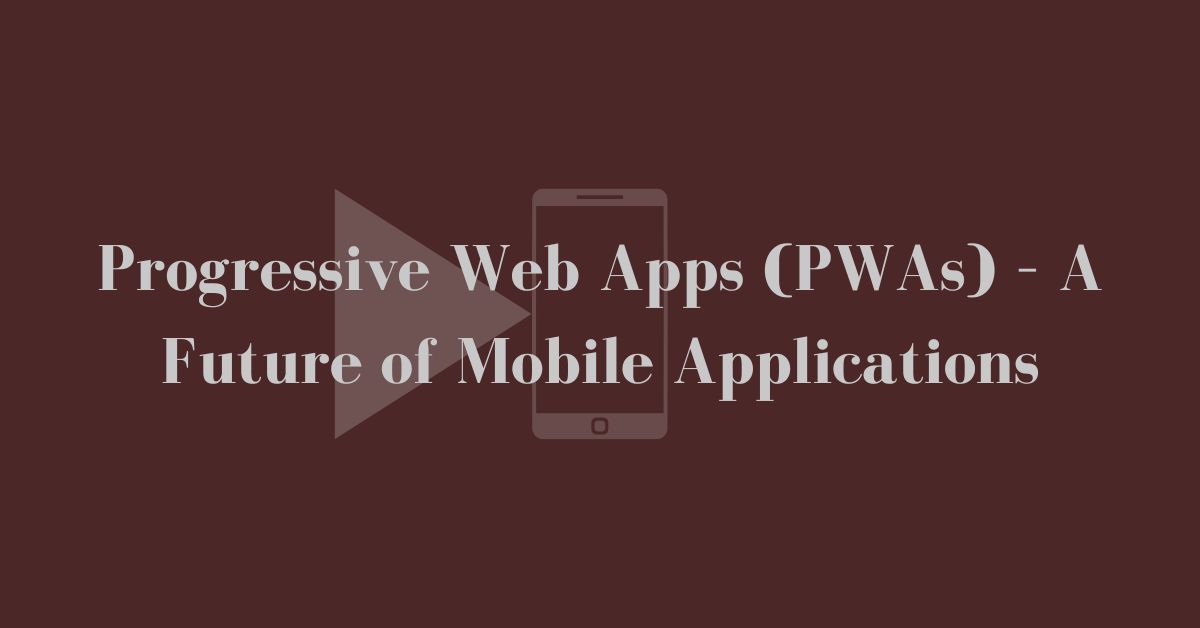|
Getting your Trinity Audio player ready... |
In an age where smartphones have become integral to daily life, mobile applications drive everything from shopping to social connections to information access. But traditional mobile app models—native apps or web apps—come with a fair share of challenges, including high development costs and limitations in accessibility across different platforms. Progressive Web Apps (PWAs) are emerging as a modern solution that offers the best of both worlds, providing app-like functionality without needing extensive installations or platform-specific development.
PWAs blend the convenience of web apps with the rich, engaging experience of native apps, promising to reshape our thinking about mobile applications.
What Are Progressive Web Apps?

A Progressive Web App (PWA) is a type of application delivered through the web, designed to function on any device and operating system with a browser. PWAs bring a native app-like experience, leveraging modern web capabilities such as offline access, notifications, and device hardware accessibility. Unlike standard web applications, PWAs use advanced technologies to ensure performance, reliability, and engagement comparable to native mobile apps.
PWAs are distinct from native apps, which require platform-specific coding (like Swift for iOS and Java for Android), as well as web apps, which are generally less interactive and lack offline capabilities. PWAs offer a streamlined user experience accessible through a URL but can also be added to the home screen and opened like a native app.
History and Evolution of PWAs
PWAs have their roots in the growing need for a more flexible, cross-platform app experience. Google introduced the concept in 2015, seeking to address the limitations of mobile web applications by offering the core benefits of native apps with the flexibility of web technologies. Since then, PWAs have continued to gain traction, thanks to enhanced browser support, improvements in service worker technology, and increasing interest from major tech companies.
Key milestones include early adopters like Twitter Lite and Pinterest, which demonstrated how PWAs could provide a fast, engaging experience even on low-connectivity networks. The development of tools and frameworks like Angular and React has further simplified PWA creation, contributing to their steady rise.
Key Features of PWAs
Several core features define PWAs and distinguish them from traditional web or mobile applications:
- Service Workers: Service workers are scripts that run in the background, enabling features like offline access, background sync, and push notifications.
- App-Like Experience: PWAs have a responsive, immersive design similar to native apps, featuring icons, splash screens, and smooth transitions.
- Offline Capabilities: Service workers allow PWAs to cache data, meaning they can work offline or in areas with poor connectivity, a feature especially valuable in emerging markets.
- Responsiveness and Adaptability: PWAs adapt to any screen size and orientation, ensuring a seamless experience on phones, tablets, desktops, and more.
These attributes make PWAs highly versatile, reliable, and accessible, even under challenging conditions or limited connectivity.
How PWAs Work
The unique functionalities of PWAs are made possible through specific technologies and tools:
- Service Workers: Acting as a network proxy, service workers handle caching, offline support, and push notifications, enabling PWAs to function even when disconnected from the internet.
- Web App Manifest: The web app manifest is a JSON file that enables developers to specify a PWA’s home screen icon, background color, orientation, and more, making it appear similar to a native app.
- Secure HTTPS Connection: PWAs run over HTTPS to ensure secure data exchanges between the app and users, safeguarding sensitive information and building user trust.
These features come together to make PWAs powerful yet easy to use, transforming the way users interact with applications on mobile and desktop devices.
Advantages of PWAs over Native Apps
PWAs offer several benefits that make them a preferred choice over traditional native apps:
- Cost-Effectiveness: Developing a single PWA eliminates the need for separate versions for different operating systems, reducing development and maintenance costs.
- Cross-Platform Compatibility: PWAs run on any device with a compatible browser, eliminating the restrictions of app stores and expanding potential user reach.
- No Installation Requirements: Unlike native apps, PWAs don’t require installation from an app store. Users can add them directly from the browser, saving storage space and simplifying access.
These factors contribute to a streamlined, user-friendly app experience and make PWAs a practical choice for companies looking to reach broader audiences without high overhead costs.
Benefits of PWAs for Businesses
For businesses, PWAs represent an efficient way to provide users with a seamless, high-performance app experience without the substantial investment associated with native app development. Key benefits include:
- Reduced Development Costs: Since PWAs only need to be developed once for universal access, companies save significantly on development and maintenance costs.
- Enhanced Reach and Accessibility: PWAs are accessible on any device and browser, enabling businesses to reach more users than with platform-specific native apps.
- Improved User Engagement: With features like push notifications, offline functionality, and home-screen installation, PWAs encourage user retention and interaction, fostering long-term engagement.
From small startups to large enterprises, PWAs allow businesses to provide a high-quality mobile experience with fewer resources and faster development times.
Examples of Successful PWAs
Several prominent companies have leveraged PWAs to reach wider audiences and improve user experience:
- Twitter Lite: Twitter’s PWA, Twitter Lite, provides a fast, data-efficient experience with support for offline access and push notifications, catering to users in areas with limited connectivity.
- Pinterest: Pinterest’s PWA resulted in a significant increase in engagement metrics and loading speeds, making it an ideal solution for mobile users worldwide.
- Uber: Uber’s PWA is designed for quick, low-data access even in areas with slow connections, showcasing the versatility and efficiency of PWAs for global audiences.
These examples highlight the scalability and potential of PWAs in delivering a high-performance, engaging experience across various industries.
Technical Requirements for Developing PWAs
Developing a Progressive Web App involves leveraging core web development technologies and adhering to best practices for optimal performance. Here are the essential elements for creating an effective PWA:
- Knowledge of HTML, CSS, and JavaScript: Proficiency in front-end languages is essential, as these are the building blocks of any web-based application. JavaScript, in particular, is critical for adding interactive features and managing service workers.
- Frameworks and Libraries: Frameworks such as Angular, React, and Vue streamline PWA development by providing reusable components, improved code structure, and enhanced functionality. Angular, for instance, includes a PWA module that simplifies configuration, while React offers React PWA plugins to assist with the transition from web to PWA.
- Web App Manifest: This JSON file defines key characteristics of the app, such as its name, icon, background color, and display preferences, enabling it to be added to the home screen and providing a native-like user experience.
- Secure HTTPS Connection: PWAs require an HTTPS connection for user security. Browsers only allow service workers to operate in secure contexts, so HTTPS is non-negotiable for ensuring data integrity and user protection.
- Service Worker Management: Service workers are the backbone of a PWA, enabling background processes like caching, notifications, and offline support. Knowledge of JavaScript and understanding how to register, activate, and update service workers is crucial.
These technical requirements ensure that PWAs are efficient, secure, and able to deliver the desired app-like experience, regardless of device or operating system.
Challenges and Limitations of PWAs
While PWAs offer numerous advantages, they also face some challenges and limitations:
- Limited Access to Device Hardware: Unlike native apps, PWAs have restricted access to device hardware, such as camera, Bluetooth, and GPS. This limitation may hinder certain functionalities, especially in apps requiring direct hardware interaction.
- Issues with iOS Compatibility: Apple has been slow in providing full PWA support on iOS. Although Safari allows PWA installations, there are limitations in push notifications, background processing, and other service worker capabilities, which impacts the experience for iOS users.
- User Perception Compared to Native Apps: Despite their advantages, some users still perceive PWAs as “lesser” versions of native apps. They may associate them with simpler web apps, unaware of their offline capabilities or home screen integration options.
As browser capabilities and PWA technologies continue to advance, these limitations are gradually reducing. However, businesses must weigh these challenges when considering PWAs for certain types of applications.
PWA vs. Native Apps: A Comparison
Understanding the differences between PWAs and native apps can clarify when and where PWAs are most suitable. Below is a comparison of some critical areas:
| Feature | PWAs | Native Apps |
|---|---|---|
| Installation | Installs directly from the browser | Installed from app stores |
| Platform Compatibility | Works across devices via browser | Platform-specific (iOS, Android) |
| Offline Access | Available via service worker caching | Full offline capabilities |
| Push Notifications | Supported on Android; limited on iOS | Fully supported on all platforms |
| Performance | High but dependent on browser capabilities | Optimized for device performance |
| Updates | Automatically updated | Requires user updates through app stores |
While native apps remain dominant for applications needing extensive hardware integration, PWAs are a versatile alternative for many business and consumer apps, offering flexibility, ease of use, and cost-effectiveness.
Future Trends and Advancements in PWAs
As technology evolves, PWAs are expected to incorporate even more sophisticated features and expand their reach. Here are a few key trends shaping the future of PWAs:
- Improved Offline Capabilities: Future advancements in service workers and caching strategies may allow PWAs to support more complex offline functionalities, even handling offline forms and other interactive features.
- Integration with IoT: As IoT devices continue to grow, PWAs may see enhanced integration with IoT networks, providing seamless experiences across smart home devices, wearables, and industrial IoT applications.
- Expanded Hardware Access: Ongoing work by browser vendors may give PWAs more access to hardware features, bridging the gap between PWAs and native apps. This expansion could include sensors, biometrics, and camera functions, allowing PWAs to cater to more sophisticated applications.
These trends highlight the potential for PWAs to become an even more powerful solution, capable of handling increasingly complex tasks and bridging more gaps between web and native experiences.
The Impact of PWAs on the Mobile App Industry
The rise of PWAs signals a significant shift in the mobile app industry. Here’s how PWAs are influencing the landscape:
- Shift in App Development Focus: PWAs offer a simplified and streamlined development process, and as more businesses recognize the cost and reach benefits, they may prioritize PWA development over traditional native apps.
- Potential Effects on App Stores: Because PWAs bypass app stores, they could impact the revenues and reach of platforms like Apple’s App Store and Google Play. Users no longer need to search and install apps through these platforms, reducing the influence of app stores in users’ mobile experiences.
- Opportunities for Startups and Small Businesses: PWAs present an affordable and effective option for startups and small businesses that might not have the resources for full-scale native app development. This democratization of app technology can encourage more innovation and entrepreneurship in the app ecosystem.
PWAs empower businesses to bypass some of the restrictions and costs associated with app store listings, giving them a direct route to reach consumers through any browser.
How to Transition to a PWA
Transitioning an existing website to a PWA can be a straightforward process. Here’s a basic step-by-step guide to help businesses make the shift:
- Create a Web App Manifest: This step involves creating a manifest file that defines the app’s appearance, theme colors, icons, and other details, enabling it to be installed and displayed like a native app.
- Set Up Service Workers: Service workers are essential for offline access, caching, and background processes. Setting up a service worker requires JavaScript knowledge to manage data caching and ensure the app remains functional offline.
- Ensure HTTPS Security: PWAs require a secure HTTPS connection for data integrity. Businesses can implement SSL certificates to secure their site and meet this standard.
- Optimize for Performance and Responsiveness: Test the PWA on various devices and screen sizes to ensure it performs well on any device, optimizing for speed, load times, and responsive design.
- Test and Deploy: Comprehensive testing across different browsers and devices is necessary to ensure the app functions as expected. Once ready, the PWA can be deployed, and users will be able to access it immediately through their browsers.
Transitioning to a PWA can be particularly beneficial for e-commerce sites, media companies, and social platforms looking to improve user engagement and accessibility without the costs of native app development.
Conclusion
Progressive Web Apps represent an innovative and highly flexible solution to many of the challenges businesses face with mobile applications. By combining the best aspects of web and native app technologies, PWAs deliver an accessible, efficient, and engaging user experience, regardless of device or operating system. PWAs allow businesses to connect with a wider audience, reduce development costs, and simplify the user journey—all while offering near-native functionality. As advancements in web technology continue, PWAs are poised to become a core part of mobile and desktop experiences, paving the way for a more inclusive and connected digital future.

FAQs
- Are PWAs secure?
- Yes, PWAs are secure as they operate over HTTPS, ensuring that data exchanged between the app and the server is encrypted and secure.
- Do PWAs work offline?
- PWAs can work offline using service workers, which cache data to enable limited functionality even when disconnected from the internet. The degree of offline functionality depends on the app’s design.
- Can PWAs replace native apps entirely?
- PWAs offer many benefits, but they may not completely replace native apps due to limitations in hardware access. However, they serve as an excellent alternative for many types of applications, especially content-driven and e-commerce platforms.
- How can businesses benefit from PWAs?
- PWAs allow businesses to reach a broader audience, reduce development and maintenance costs, and provide a seamless, app-like experience without requiring users to download or install anything.
- What are the key differences between PWAs and native apps?
- PWAs are cross-platform, don’t require installation, and work in browsers, while native apps are platform-specific and need to be downloaded. PWAs offer offline capabilities and push notifications but have limited hardware access compared to native apps.
What Are HTML5 Semantic Elements And Their Usage?
How To Make User List UI design In Bootstrap?
What is the Difference Between CSS Grid and Flexbox?
Arsalan Malik is a passionate Software Engineer and the Founder of Makemychance.com. A proud CDAC-qualified developer, Arsalan specializes in full-stack web development, with expertise in technologies like Node.js, PHP, WordPress, React, and modern CSS frameworks.
He actively shares his knowledge and insights with the developer community on platforms like Dev.to and engages with professionals worldwide through LinkedIn.
Arsalan believes in building real-world projects that not only solve problems but also educate and empower users. His mission is to make technology simple, accessible, and impactful for everyone.



